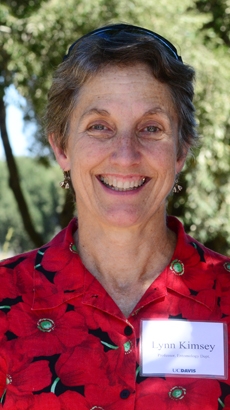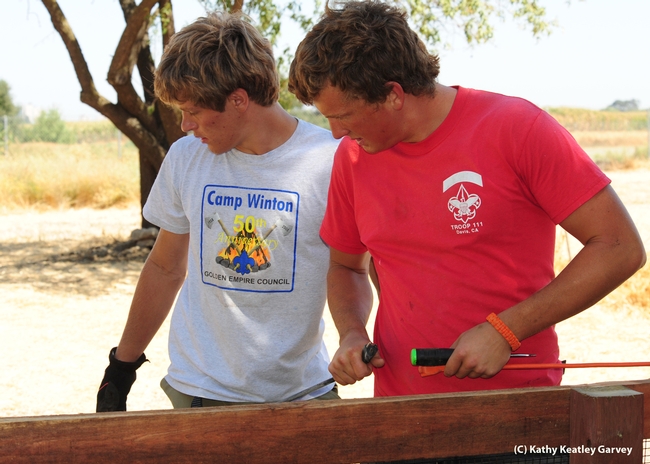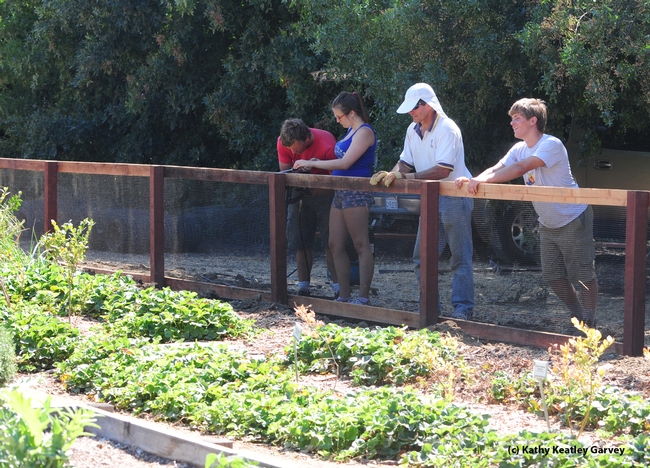
So agreed the visitors attending the open house and recognition ceremony last Saturday, Sept. 15 at the Häagen-Dazs Honey Bee Haven, a half-acre pollinator garden next to the UC Davis Department of Entomology's Harry H. Laidlaw Jr. Honey Bee Research Facility)
They toured the garden, listened to the recognition ceremony, and joined the garden tour, admiring the plants and art work by the UC Davis Art/Science Fusion Program. They left feeling that this is indeed a very special place on earth.
The recognition ceremony paid tribute to Derek Tully, 17, of Davis, who, as his Eagle Scout project, built a state-of-the-art fence around the garden.
The fence is "fabulous," Lynn Kimsey, director of the Bohart Museum of Entomology and professor of entomology at UC Davis, told the gathering at the 1:30 p.m. recognition ceremony. Kimsey served as the faculty liaison for the Eagle Scout project.
Kimsey recounted how Tully, a member of Troop 111, planned and built the post-and-rail fence with the help of a 33-member volunteer crew that he organized and supervised.
Tully launched the project April 2 and completed it Sept. 7. The fence builders included his father, Larry Tully, a retired machinist from the Lawrence Berkeley National Laboratory. Larry and his wife, Leslie Woodhouse, a research support supervisor at the USDA Western Human Nutrition Research Center on the UC Davis campus, serve as assistant scoutmasters of Troop 111.
Tully recruited greenhouse superintendent Garry Pearson, UC Davis College of Agricultural and Environmental Sciences, who augured the holes for the fence posts. The project required 91 fence posts, 211 2x4s, 46 2x6 railings (each 20 feet long), four yards of gravel, 18 bags of concrete, and 12 rolls of wiring at 100 feet each.
The post-and-rail fence is wire-meshed, with the wire extending underground to inhibit jackrabbits, ground squirrels and pocket gophers from turning it into their version of Mr. McGregor's garden.
Derek negotiated with area businesses to obtain discounted prices. The total cost of materials: $6300. The number of volunteer hours: 488 hours and 15 minutes. Kimsey estimated that the project saved the department $24,000 to $30,000.
In building the fence, the crew toiled in triple-digit temperatures as bees (from the adjacent Laidlaw facility) and butterflies and other insects nectared the flowers. Occasionally as the volunteers nailed boards to the fence, praying mantids and spiders engaged in their own kind of nailing--nailing bees.
If you visit the garden, located on Bee Biology Road, off Hutchison Drive/Hopkins Road, west of the central campus, you'll not only see "The Fence that Derek Built" but plants, predators and prey that form the very microcosm of this pollinator garden.
Attached Images:

Derek Tully (right) and fellow scout Willie Hawkins work on the fence surrounding the half-acre pollinator garden. (Photo by Kathy Keatley Garvey)

Derek Tully (right) with his parents, Larry Tully and Leslie Woodhouse, assistant scoutmasters of Troop 111. (Photo by Kathy Keatley Garvey)

Stapling wire to the fence are (from left) Derek Tully and his girlfriend, Emily Talbot, while father and son Dave Hawkins and Willie Hawkins of Troop 111 straighten the wiring. (Photo by Kathy Keatley Garvey)